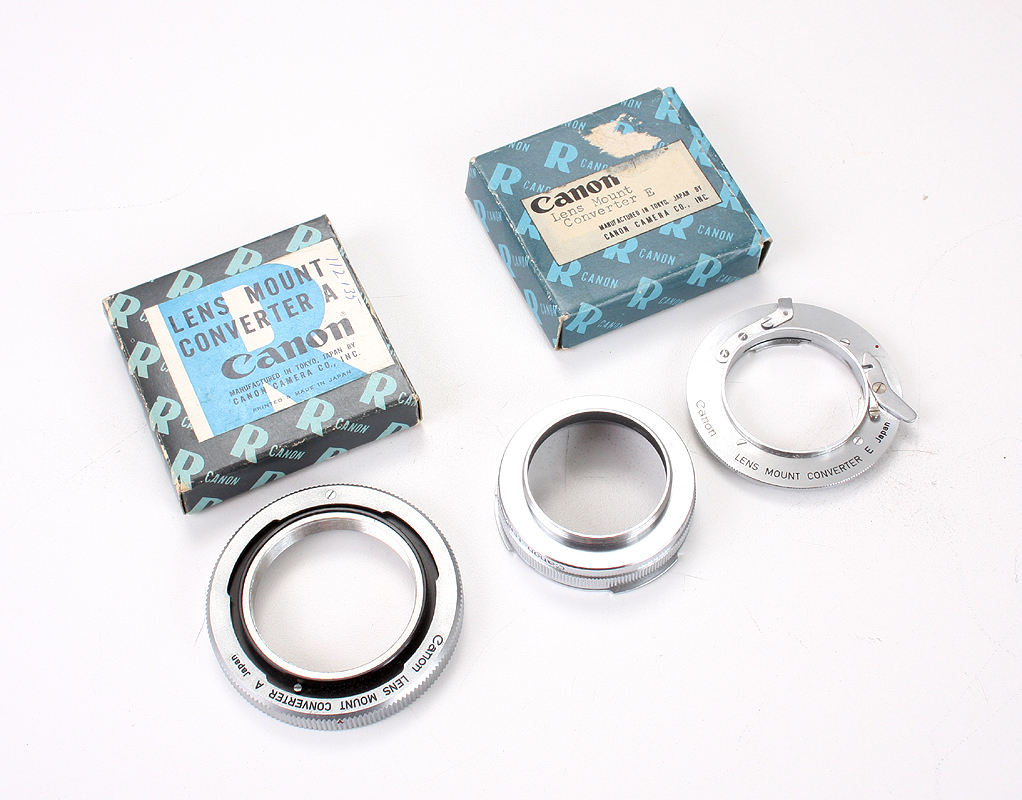
Photographica Pages
An online guide to collectable cameras and related stuff
Canon Canonflex Mount Adapters
Adapters are a subject that involves technology, marketing and politics. Which adapters you can make
are dictated by technology, will it be profitable is determined by marketing, and will they help or hurt the
prestige of your brand becomes political.
A camera lens must be mounted at a certain distance from the film to achieve infinity focus. The flange
being where the lens attaches to the body, the thickness of the body (or the film-to-flange distance).
Lenses can really only be adapted from cameras with a longer film to flange distance than the camera
you want to mount it to. It is also helpful if the camera has a wider throat than the body the lens came
off of. The exception is that you can build an adapter with optics inside to correct for placemtn of the
lens further out than the lens was designed for. These adpaters tend to be more expensive, and adding
a correction lens is never going to increase the optical performance.
The marketing and politics are a bit trickier to figure out. If you are trying to break into the market and
have a limited line of lenses you can offer, an adapter helps you sell bodies. But perhaps at a cost of
lens sales. If you are a company with a proud history as an optical house, you might feel offering lens
adapters is beneath you. Leitz, Zeiss, Nikon and Voigtlander generally didn't. Minolta, Konica, Miranda
and Canon did.
Canon offered Lens Mount Converters A, B and E. But really the Lens Mount Converter E was the only
real concession to using someone elses lenses. The Exakta had been on the market since the 1930s,
and there were (and still are) a lot of highly regarded lenses, Zeiss, Schneider, Angeniuex to name
three, which were available in Exakta mount. And Ihagee had been lagging in modernizing their bodies.
Canon probably felt there was a great opportunity to poach Exakta users with their more modern
bodies.
The Lens Mount Converters A and B adapt to and fron Leica thread mount. While Canon rangefinder
cameras used Leica thread mount, the point of these adapters was not really to incorporate the
rangefinder lenses into the SLR system. Their back focus makes them useless except for close-up
work. As Leica originated the 24x36mm 35mm format, and their enlargers were both among (if not the)
first for the format, and were designed to use Leica camera lenses. As a result Leica 39mm thread
mount became the standard for 35mm enlargers. When lens designers started producing lenses
specifically for enlarging, they used this lens mount. Those lenses tended to be flat field corrected (the
focal plane tended to optimized to avoid curvature), and were also optimized for sharpness at a short
distance rather than infinity. These are traits that are useful in close-up work and copying. Much of the
close-up equipment of that time used 39mm thread mount. It didn't hurt that Canon's close-up
equipment for the rangefinder cameras were in this mount already, so they didn't have to market
different versions of some of the same equipment (although tht equipment was mostly pretty
simple).
The Lens Mount Converter A allows 39mm thread accessories to mpount onto the Canonflex bodies,
and the lens Mount Converter B allows the mounting of Canonflex lenses to 39mm accessoires...and
bodies with correct infinity focus. This was of limited usefullness as the lenses were not rangefinder
coupled and had to be scale focused. That changed with the introduction of the 19/3.5 Canon FL, but
that is a different story from a different era, to be dealt with on a different page.
The price in March 1964 was $11.50 for the Lens Mount Converter A, $6.50 for the Lens Mount
Converter B and $7.95 for the Lens Mount Converter E. The Canonflex era adapters can be identified
by the dark green/teal boxes with the repeating Canon R logos. They are a little heavier than the later
ones, and the chrome finish is a bit brighter. But they were continued in their basic form until the end of
the FD era.

The Lens Mount Converters A, B and E (left to right), with the boxes for the A and E.

The Lens Mount Converters A, B and E (left to right), with the boxes for the A and E.
